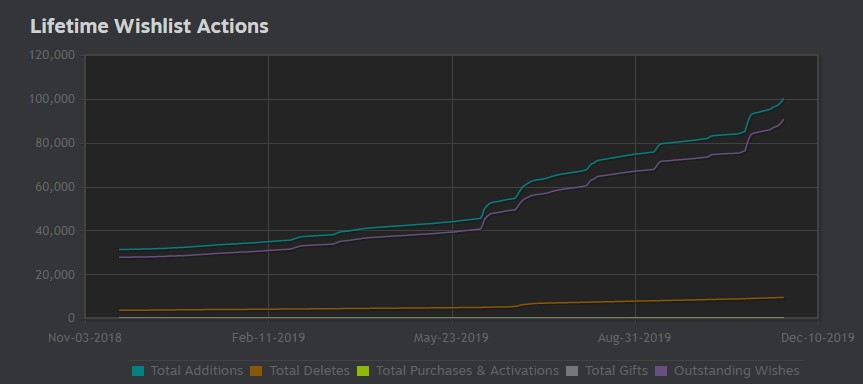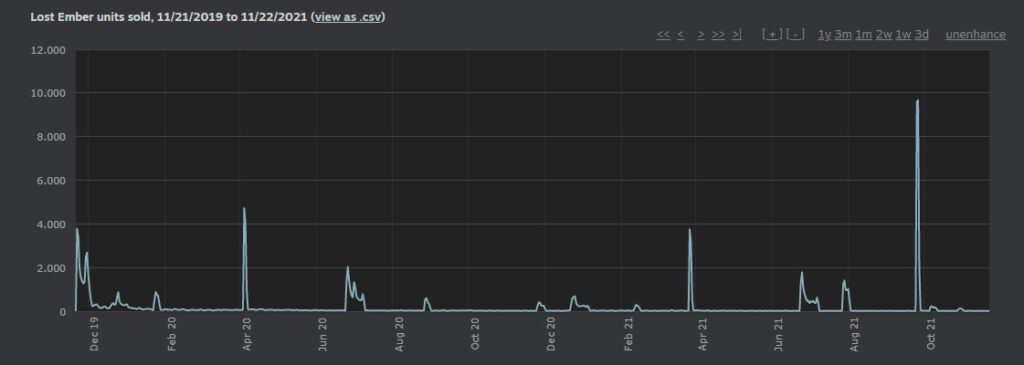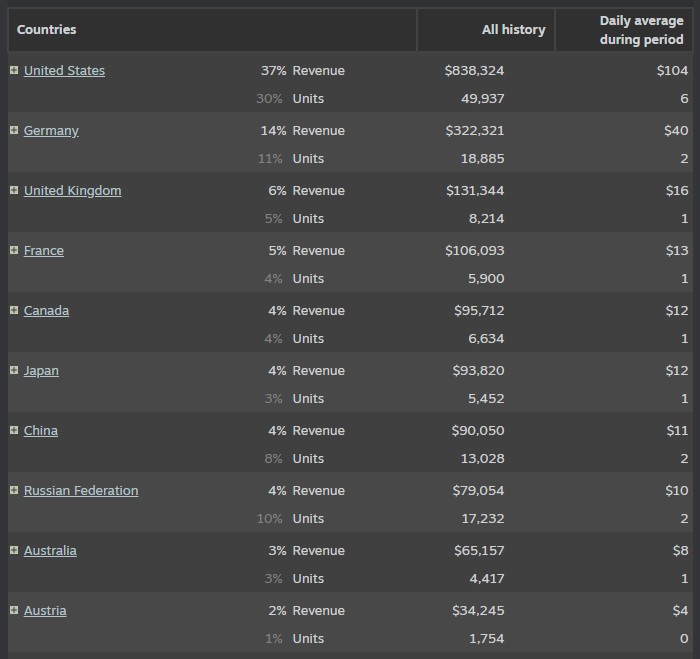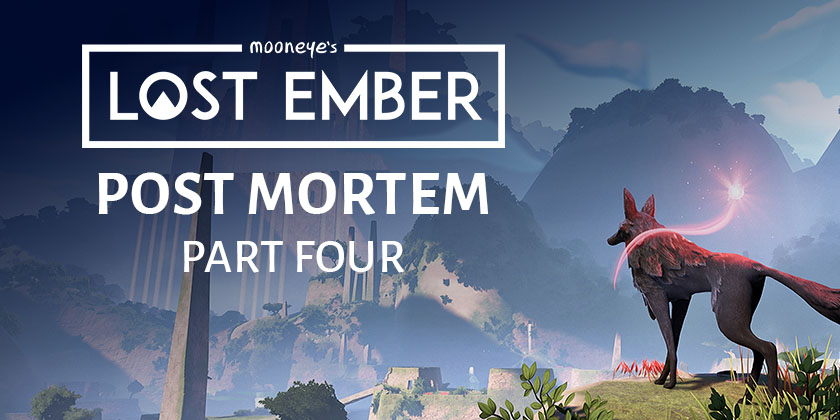And here we are: the final part of our post mortem. Writing all this has brought back a lot of memories from “back in the day” and was quite cathartic, in a way. And I hope you lot could learn something from it or at least had fun reading it.
And if you have no idea what I’m talking about, it may be worth going back to the start of the series:
This time I’m finally coming to the juicy bit (at least for anyone dealing with budgets, for anyone else this is probably the boring bit): the numbers.
Lost Ember has been very successful and profitable for us. One of the benefits of having a small team like ours is obviously that it’s not costing as much to keep it running. We don’t need to sell millions of copies of a game for it to be profitable. But we still need to sell more than the average indie game does, so we were still extremely nervous before hitting that release button. We had been working on Lost Ember for over five years now and put a lot of money, time, love, sweat, tears, and nerves into it and we didn’t want it to have been for nothing. An okay release would at least mean that we would have a better standing in future publisher pitches and would likely get better deals, since we can already prove that we can actually ship a game that people enjoy. But a complete flop and disappointed Kickstarter backers would not only look bad for future publisher pitches, but probably also for future Kickstarter campaigns we may plan. Ideally it would even allow us to start working on the next project for a while without having to immediately think about running out of money.
The total development budget of Lost Ember added up to about 800,000€ (900,000$), not counting any cost for patches and marketing after the release. Game development is pretty expensive…
The Kickstarter was the biggest chunk of our budget, but there also were a lot of other sources. New team members, a delayed release and porting support were things we didn’t calculate for, so even after the Kickstarter the search for additional funding did not stop. Luckily, the successful crowdfunding campaign was a pretty good argument for new investors and so we were able to secure the remaining budget with a mix of public funding, private investors and could even convince a bank to loan us some money (not the easiest thing to do as a startup without a released product). The full budget breakdown looked something like this:
- 220k€ Kickstarter (after taxes and production of rewards)
- 130k€ public funding
- 130k€ private investor
- 130k€ bank loan
- 70k€ from contract work and other side jobs
- 70k€ private loans
- 25k€ personal funds
- 25k€ awards
About 450,000€ (510,000$) of that budget we had to pay back in some way after the release.
Of that full budget, about 105,000€ (118,000$) was spent on marketing – not counting time spent on social media and newsletters etc. Most of our marketing consisted of ads on social media, but we also tested banner ads and showed Lost Ember at different conventions. The question how much you should spend on marketing is one that we hear pretty often from young developers, so I thought it might make sense to break down our marketing spendings as well. This is more or less everything we did in traditional marketing before and during the release:
- 40k€ Facebook Ads (50% of that before release, the rest around the release date)
- 30k€ Conventions
- 13k€ Youtube Ads
- 10k€ PR (we hired an external PR agency for the release)
- 5k€ Instagram Ads
- 5k€ Banner ads
- 2k€ Twitter Ads
The way we decide which platform to put our money into is pretty straightforward. We post ads to everything we can think of and then put the rest of the money towards the platforms that performs best. For Lost Ember that was Facebook for a while, so this is where most of our advertising budget went. Lately, TikTok has taken over as the main platform, so it’s worth repeating those tests every once in a while since user preferences may change.
How much did Lost Ember make?
We released Lost Ember simultaneously on Steam, GOG, Humble Store, PlayStation 4 and Xbox One. There’s a couple of predictions going around that tell you how many sales you can expect for so-and-so many wishlists in your first week, and then other predictions for sales in the first year after your first week. Let’s see if those predictions were correct for Lost Ember.
The expected “wishlists to first week sales” ratio lies somewhere between 0.2 and 0.3 sales per wishlists for most indie games. After the first year, the average Steam game can expect 3x its first week sales. We launched Lost Ember with pretty much exactly 100,000 wishlists on Steam. This meant we should expect between 20,000 and 30,000 sales in the first week and 60,000-90,000 after one year. A pretty decent outlook, but was it correct?

We launched a week before the Steam Autumn Sale and Valve agreed to let us extend our launch discount of 10% throughout the sale duration, meaning Lost Ember would be featured in its first major Steam event just a week after release. It’s always worth talking to platform holders about those kinds of promotions. Mostly there’s not too much they can do, but sometimes you’re lucky.
The first week and month are always the most important. They determine your visibility over the next months, since most stores will feature top selling games for longer. In our first week we sold 23,000 copies of the game across all platforms, with Steam being by far the best-performing of them. Which is pretty good! There were a couple of parties that would get revenue shares, especially from the first sales until they had recouped their investments or loans we had to pay back with that first money, but there still was a decent amount left for us and it did make us very optimistic for the future. We knew after a couple of days that Lost Ember would not flop – and probably even be pretty profitable.

The first month ended with 40,000 copies sold (see how it’s not even double the sales of the first week?). After 4 months, it had recouped its full budget. We hit the mark of 100,000 copies after about 9 months and at the moment we’re at 250,000 copies with an average price of about 15€ (17$), before any platform cut or other revenue shares. That’s not only lower than the normal price because of discounts, but also because of regional price differences. Usually games tend to be a lot cheaper than they are in Europe or the US in countries like China or Brazil, so the average price of a game – even if it never has a discount – will never be what you see as the price in your country.
And that’s also something to keep in mind when setting the base price of your game! A higher price can give you more leeway for discounts and special promotions like bundles without giving away the game for more or less nothing. It can also mean that people will inform themselves a bit more about the game before a purchase, leading to more positive reviews because they know what they’re buying. But of course it can also mean that it’s too expensice for a lot of people and no one will buy it. It’s a hard balance to find and depends very much on the individual project.
Most indie games will never see those numbers, so we are extremely happy with how Lost Ember performed. Unfortunately, there’s some taxes and things like that involved in earning a lot of money and – as I mentioned – there are various parties that get a cut from that money, so it’s not quite as amazing as it sounds at first, but it still enabled us to put some of the money aside to support other developers of amazing indie games that are in the same position as we were just a couple of years ago with our new publishing label “Mooneye Indies” – which is something that we talked about for a long time but didn’t really think would happen this early.
And speaking about countries, here’s a list of the top 10 countries in terms of revenue for Lost Ember:

Nothing too surprising for us there, but it still might be interesting for some of you. We’re a German studio, so we expected the German market share to be higher than usual. It’s worth noting the differences in units and revenue for some countries, which is again a sign of the different prices in those countries. While Russia made up 10% of all units sold, it’s only 4% of the revenue.
Coming back to the predictions: on Steam alone, Lost Ember performed under our predictions, but of course with a multi-platform release, some Steam wishlisters will decide to buy the game on another platform. If you count all platforms, Lost Ember is slightly above the average. On Steam alone, our sales look like this:
- 100,000 wishlists before release
- 17,000 sales after week 1
- 74,000 sales after year 1
- 134,000 sales after year 2
Resulting in the following prediction formula for copies sold on Steam:
Year 2 = 1.81 x Year 1 = 1.81 x (4.35 x Week 1) = 1.81 x (4.35 x (0.17 x Wishlists))
The arguably more relevant formula for copies sold on all platforms:
Year 2 = 1.9 x Year 1 = 1.9 x (5.24 x Week 1) = 1.9 x (5.24 x (0.23 x Wishlists))
For the total revenue after the platforms cuts, the calculation goes something like this:
Year 2 = 1.43 x Year 1 = 1.43 x (5.79 x Week 1)
The numbers are slightly skewed since we released the Switch version of Lost Ember 10 months after the initial release, which is the main reason why the year-1-to-week-1-multiplier for all platforms is that much higher than for Steam alone.
As a reference for what this meant for us, we spend about 300,000€ (340,000$) a year as our usual yearly burn rate without special marketing costs (that depend very much on the year, obviously). Meaning that even without the other funding options we already secured for our next project, Lost Ember could pay to keep the company afloat for a pretty good while.
Managing a multi-platform release
As I already mentioned, Steam was and is by far the most lucrative platform for Lost Ember. This is true for a lot, but certainly not all indie games. The first game we published in our “Mooneye Indies” label, for example, performed way better on Switch than Steam. But at least on PC, Steam is pretty much still the only relevant storefront. We also released Lost Ember on GOG and the Humble Store, but compared to Steam, sales there are more or less negligible. We did not release it on the Epic Game Store, yet, so that may be an interesting comparison, but so far there’s still no real way around Steam, if you’re releasing on PC.
One thing to mention for Steam is that after a while, most sales will happen during special Steam events like the Summer Sale – and therefore with a big discount. Console sales are a bit more consistent.
The consoles among themselves weren’t too different from one another in terms of sales.
What happens after the release?
The work does not end with just pressing that release button and – depending on how successful your game is – it is worth spending some additional time on fixing bugs or making some general improvements that you never had time for before or that were suggested by the community. You obviously want to keep your Steam user ratings as high as possible since that will have a big influence on future sales. For Lost Ember, we are still publishing patches and general improvements for all platforms, although the main focus has already shifted to a new project.
One thing that is always worth considering after a successful release is publishing the game on more platforms. With Lost Ember, we started working on a Switch port pretty much immediately after the initial release. Initially, we thought this would just be an additional two or three months of work, but it ended up taking nine months just to get it running smoothly. The Switch – after all – has a lot less power under the hood than the other consoles, so there was a significant amount of optimization necessary to get it running. But already, the Switch has overtaken one and is on a good way of leveling with another platform, so it was definitely worth the time.
General support and community management is another aspect of game development that can cost a lot of time after release. Luckily, we have an amazing community that is very supportive and does not cost too many nerves, but of course there’s still some work to do just answering emails, comments and direct messages on different platforms. If we had not done so before, now would definitely have been the time to hire an additional team member that can focus on that without slowing down the development itself.
And besides working on patches, overall communication and starting work on a new project, you should always keep an eye out for promotions and events that could be a good fit for your game since, as I already mentioned, most sales will happen during those times after a while. It’s definitely worth a lot to just keep up to date with different platform holders and other developers of similar games, since you never know when one of them will initiate talks about some kind of promotion that you could be a part of. As with most things, networking and good relationships with others in the industry are very important for that.
This is also something about the indie game industry that makes it a very fun and positive work environment. Most people from other studios won’t see you as competition, but as like-minded friends.
Top Learnings
So, what have we learnt from all this? Is there a TL;DR version of all this text? Let me try to collect the main things to take away, if you’re in a similar situation as we were.
- Start building a community early and tell them how they can support you (this will be your main point of reference for sales)
- Test your game frequently and with different people (fresh eyes can reveal a lot of weaknesses that you have gone blind for)
- Don’t be afraid to “kill your darlings” (you can lose a lot of time trying to make something work that just doesn’t)
- Test your marketing strategy in small doses (no matter for what, it could be a trailer or some screenshots, just try around with putting some advertising money behind it to get a feeling for how it works. This can also give you a better idea of the general interest for your game idea)
- Talk to other developers (you cannot keep track of everything going on around you that is worth spending time on, so talking to others could potentially make you aware of huge opportunities that you have missed)
- Have fun (the game industry is no industry to join if all you want is to make money. If you don’t have fun working on games, you’re doing something wrong)
Obviously every game is different, so you might choose to go another route than we did and that might be the right decision for you. I’m not saying that if you don’t follow this advice you will fail. It’s simply an example of how you can be successful as an indie game developer. And since it’s still very hard to get your game noticed in this industry, I hope hearing about cases when it actually did work is motivating for some of you.
And this concludes our little expedition into our past. I hope it was helpful for a lot of you and at least fun to read for the rest. I always have fun sharing our experiences and reflecting on the past, so if there’s a specific element of releasing a game that you think I could have gone into more detail about, please share your questions and suggestions!
For now, I hope you’ll have a great rest of the day! See you again soon,
-Tobias
